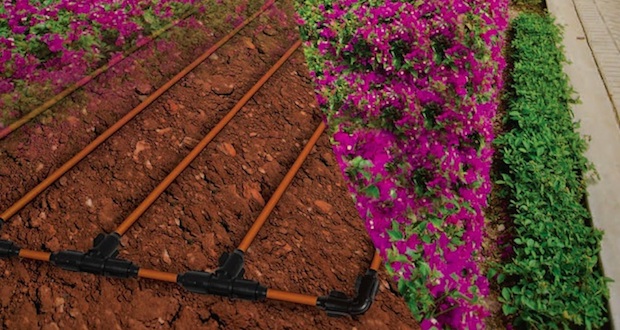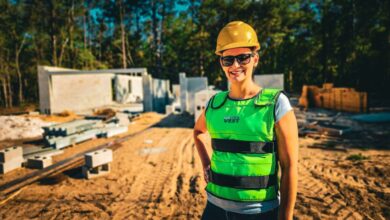How Drip Irrigation Helps Conserve Water
By Ryan Larsen

The theory of drip irrigation, also known as low volume or micro irrigation, is simple. Through a network of plastic tubing and low-volume drippers and sprinklers that reach every part of your target area, water is delivered on a slow, frequent and accurate basis directly to the root zone of the plant. It causes water to radiate outward from its source point, creating an overlapping wetting pattern beneath the ground. The root zone is kept moist but never saturated with water. The end result is that the plant always maintains the ideal balance between water and air.
Due to the increased focus on water conservation in state regulations, homeowners and commercial property managers are using drip irrigation more and more every day to save water while also improving efficiency and reducing maintenance. In fact, many drip irrigation products are granted exemptions from their water management district restrictions due to their high level of efficiency. This means homeowners and property managers can water their landscapes while other forms of irrigation, such as the common sprinkler systems or hand watering, are being restricted or banned (check with your local water management agency for qualifying products.)
Benefits of drip irrigation
Drip irrigation is ideal for a variety of applications, including watering larger trees, foundation planting and raised planters, landscapes and shrubs, medians and roadways, and subsurface turfs and sports fields. Its many benefits include:
- Water savings. Drip irrigation can reduce water use by 30 to 70 percent compared to conventional sprinkler irrigation. Sprinklers can waste water due to scattered spray from winds, evaporation, run-off or deep leaching.
- Healthier plants. Shrubs, plants and turf grass thrive with a slow, steady application of water and nutrients directly to the plant’s roots. The ideal soil moisture level also minimizes plant stress, which spurs faster growth. Drip irrigation also prevents unsightly brown spots on flowers because spray never touches the plants, and it reduces fungal diseases by keeping the soil surface and foliage dry.
- Aesthetics. There are no unobtrusive risers or sprinkler heads to lessen the aesthetic value of a landscape. Drip irrigation can be hidden under mulch or beneath the soil, which also eliminates spray on buildings, windows, fencing or pedestrians in high-traffic areas.
- Reduced weed growth. Because drip irrigation only covers a relatively small part of the soil’s surface around the plant, weeds receive less water and subsequently have less opportunity to grow.
- Automation. Drip systems can easily be automated by hooking the system into conventional electric valves and timers.
- Optimal fertilization. Water-soluble plant food can easily be applied through the filter, to the drip system, directly to the plant root zone.
- Use on slopes. Traditional sprinklers often create wasteful run-off when used to water upper slopes of hills. Drip irrigation applies the water slowly enough to allow all the moisture to soak directly into the soil.
- Reduced labor and maintenance. Dripline installations have lower average material costs when compared to sprinklers. And, conventional sprinklers require constant maintenance to adjust spray patterns and nozzles, and have moving parts that require repair. Dripline maintenance is minimal and limited to periodic flushing and system evaluation.
- Ease of installation. Dripline irrigation installs easily in tight, awkwardly shaped areas that are hard to water with standard sprinkler systems. Driplines are typically very flexible and can adapt to any planting shape.
Types of drip irrigation
Drip irrigation products can be broken into five categories. These five options can be combined in any application, but keep in mind that each method may have different watering cycles. Hence, it is generally recommended that the different methods be put on separate circuits and operated independently, either manually or through a multi-station timer.
- Point source drip:
The most precise option, drip emitters deliver water directly to the soil at the root zone at very slow application rates. Drip emitters are best suited to shrubs, trees, hanging baskets, etc. Because of the low discharge rate, the watering cycle is usually longer. - Bubbler:
Used most often for shrubs and trees, bubblers have higher discharge rates and shorter watering cycles. Because bubblers can operate at high pressures, they are particularly useful for conversion from conventional sprinkler to low-volume systems. - Micro-spray:
When low-volume overhead irrigation is desired, micro-spray is best for ground covers, and plants such as ferns, which prefer some humidity. - Dripperline:
Dripperline is the fastest growing and easiest to install type of drip irrigation. For watering closely spaced plants, hedges, vegetable gardens, etc., dripperline is best. Other applications include planter boxes and rings for large pots, as well as containers and loops around large trees. - Mister:
Ideal for watering hanging baskets and for creating humidity, misters are normally used in the inverted position and spray downwards. A growing application of misters is for outdoor cooling, where the immediate evaporation of mist can dramatically reduce the air temperature.
Soil considerations
Subsurface irrigation works better in heavy clay or sand conditions than overhead sprinkler systems. Loam, which contains equal proportions of sand, silt and clay, is ideal. However, plants can thrive in a very broad spectrum of soil textures when subsurface watering is applied at the proper rate, with appropriate spacing.
Case studies
A newly built home in Jacksonville, Fla., was using a non-pressure regulated overhead sprinkler irrigation system to water both plant and turf areas. Using a single system for both plant and turf areas resulted in excessive overspray and very long run times.
NDS irrigation experts reviewed the existing system, and the total system flow (flows from all spray and rotor nozzles and their respective run times) was using 110 gallons per minute. A better, more efficient irrigation was needed.
NDS technicians designed a new system to convert the turf areas to subsurface dripperline irrigation system, and the landscaped areas to on-surface drip irrigation. The result: water use dropped from 110 gallons per minute to 68 — a 62 percent reduction — and the average monthly water bill dropped from $105 to just $40 with the modifications.
In another example, this time in a commercial setting, the owners of the Market Place Shopping Center in Tustin, Calif., had been utilizing spray irrigation to water their landscaping, but their results were mixed. On the plus side, the plants were watered regularly. The downside: the grounds beyond the landscaped areas were also getting soaked, which meant water runoff onto sidewalks and parking areas. To conserve water and prevent customers’ cars from being sprayed, a drip irrigation system was recommended. An NDS Dura Flo Check Valve Dripline was determined to be the ideal solution. The result was straightforward installation and a more efficient, water-saving system than what the company had previously been using.
Ryan Larsen is a civil engineer and technical services manager at NDS, Inc., which manufactures efficient irrigation products for residential and commercial markets. He has nearly a decade of experience in civil engineering, land development, and the building materials and construction industry. For more information about NDS, Inc. and its irrigation products, visit NDSpro.com.


